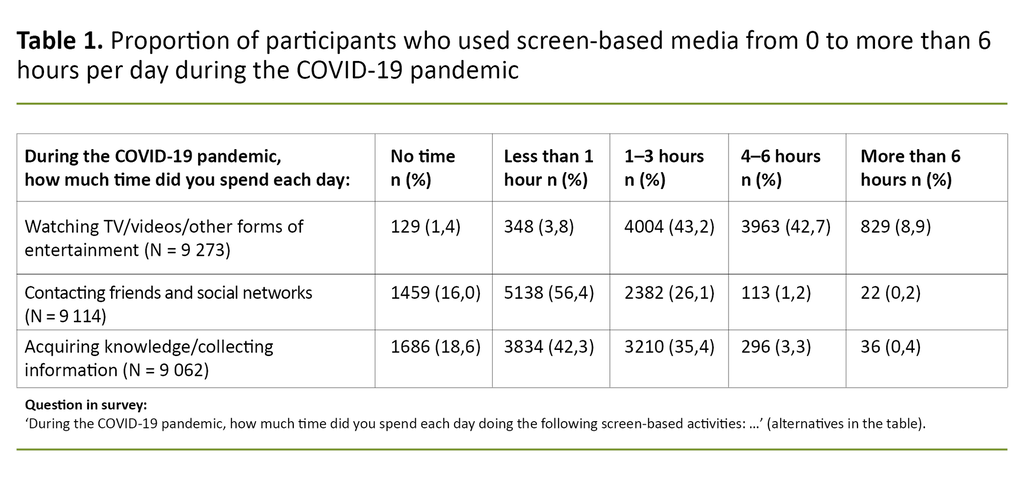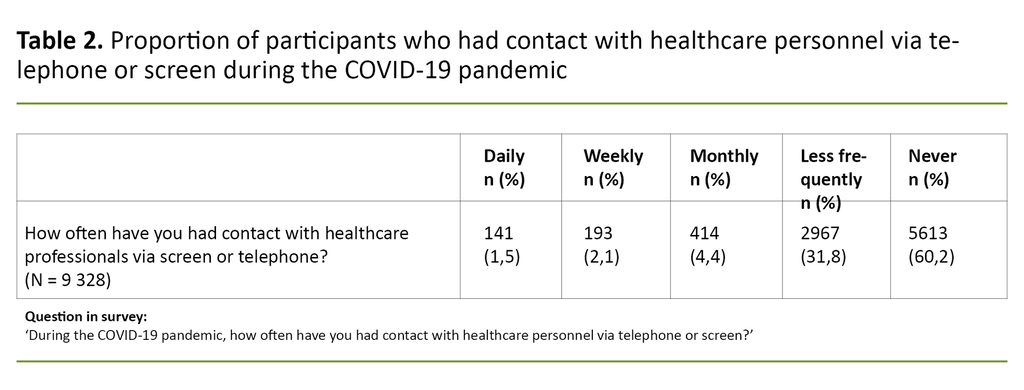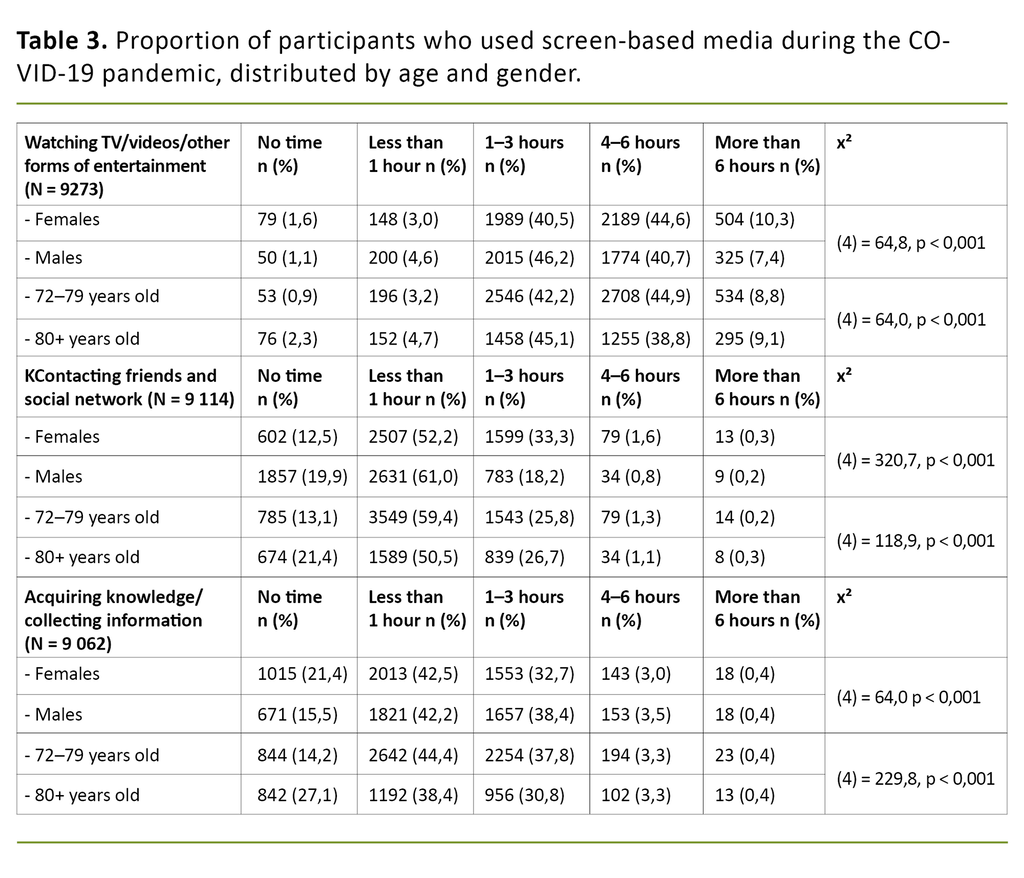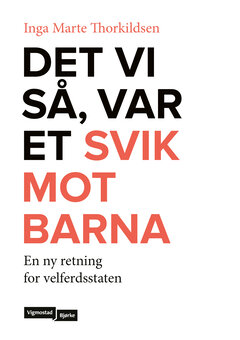Use of screen-based media among older people during the COVID-19 pandemic. A HUNT study
Almost 84% of people over the age of 70 used a computer, smartphone or tablet to maintain contact with their friends and social networks. Only 8% used these media to contact healthcare personnel.
Background: Older people are particularly vulnerable to critical or fatal illness as a result of infection with the corona virus and have been encouraged to self-isolate during the pandemic. The importance of screen-based media and telephones as tools to help prevent loneliness, maintain contact with friends and family, and ensure necessary follow-up by healthcare services has been highlighted. However, knowledge about how older people have used screen-based media during the pandemic has been lacking.
Objective: The objective of the study was to examine how people over the age of 70 used screen-based media for the purposes of entertainment, collecting information and maintaining contact with friends, social networks and healthcare personnel. Furthermore, we wanted to find out how gender and age influenced the use of screen-based media.
Method: In January 2021, we mailed a questionnaire to 12 772 people who had participated in the fourth round of the Trøndelag Health Study (the HUNT 4 Survey) in the period 2017–19 and were 70 years of age or older at the time. Participants were asked to indicate how much time they spent each day using screen-based media for entertainment purposes, contacting friends or social networks and acquiring knowledge or information.
Results: A total of 9 391people (73.5%), aged 72–106, responded to the questionnaire. Of these, 83.9% used screen-based media to maintain contact with friends and social networks, and 8% had been in contact with healthcare personnel using this media. More women than men and more people in the under 80 age group than in other age groups used screens to maintain contact with others.
Conclusion: A large proportion of older people used screen-based media during the pandemic. The study revealed that there had been little contact between older people and healthcare personnel using telephones or screens. Efforts should be made to boost this form of contact while, at the same time, attention needs to be focused on the oldest segment of the population who do not use communication technology.
The main strategy for preventing infection during the COVID-19 pandemic has been to restrict physical contact between people. Older people are particularly vulnerable to critical or fatal illness as a result of infection with the corona virus (1), and the recommended restrictions have been especially extensive for this segment of the population. Activities arranged by local authorities, such as exercise groups and day care activities, have been suspended and cultural events have been cancelled. There have been periods when residents of nursing homes have not been permitted to have visitors, or when the number and frequency of visitors have been restricted (2, 3).
Social isolation and loneliness among older people increases the risk of mental and somatic illnesses, such as depression, anxiety, coronary disease and strokes (4, 5). Furthermore, social isolation and loneliness can lead to an increased need for healthcare services (6) and higher mortality rates (7, 8).
During the COVID-19 pandemic, screen-based media, such as video calls and phone calls, have been highlighted as important tools for maintaining contact and preventing loneliness (9) for all age groups. A total of 96% of the Norwegian population has access to a smartphone, and 98% of the adult population are active internet users (10).
Over recent years, there has been an increase in the use of internet-based news sources, and figures from 2020 indicate that 88% used internet-based media on a weekly basis to search for news (11). During the COVID-19 pandemic, however, there has been a change, and more of the adult population have watched the news on linear TV (12).
People over the age of 60 use social media such as Facebook for social contact and to expand their social networks (13). The national health authorities have pointed to the need to improve access to screen-based media on digital platforms to enable more people over the age of 65 to use them. The aim is to equip older people to participate in key social arenas, and enable them to search for digital sources of health information (14, 15).
Moreover, it is the aim of the Norwegian Government to digitalise more health and care services (16). The Norwegian Directorate of Health stresses that healthcare facilities and healthcare personnel have a responsibility to help maintain social contact between service users or patients and their families. Screen-based media have been highlighted as key tools for achieving this (17).
Some older people choose not to use screen-based media (18). This may be due to them not finding it useful, being afraid of making mistakes or not wanting to bother other people by asking for help. It may also be a question of finances (19). For some, it is due to concern about privacy and security issues (18).
There is also reason to believe that cognitive problems and sensory impairments can make it difficult to use screen-based media. A Norwegian study focusing on the use of social media among people over the age of 60 found that the oldest people in the sample (the 80+ group) used social media less than those in the youngest segment (60-69 years of age). Older people with a higher education, good health and a partner used social media the most (29).
The objective of the study
In this study, we wanted to examine the extent to which people over the age of 70 used screen-based media for entertainment purposes, as a source of information and to maintain contact with friends, social networks and healthcare personnel during the COVID-19 pandemic. Furthermore, we wanted to find out how gender and age influenced the use of screen-based media.
Method
Participants
The study was designed as a cross-sectional study. In January 2021, we sent out a questionnaire on the use of screen-based media, such as TVs, computers and smartphones, during the COVID-19 pandemic. The questionnaire was sent to all participants in the Trøndelag Health Study (HUNT) who were 70 years of age or older when they participated in the fourth round of the survey (HUNT 4 Survey, 2017–19).
The Trøndelag Health Study is a population study in which the entire adult population from the same geographic area was invited to participate in four survey rounds. The first round was carried out in 1984 (21). We mailed the questionnaire together with a stamped and addressed return envelope to 12 772 people.
Variables
The questionnaire covered several topics, and in this article we have chosen to focus on four of the six questions that dealt with the use of screen-based media during the COVID-19 pandemic. The participants were asked to state how much time they spent each day using screen-based media for entertainment purposes, contacting friends or social networks, as well as acquiring knowledge or information respectively.
In addition, they were asked if they had been in contact with healthcare personnel using a telephone or other screen-based medium on a daily or weekly basis, less frequently or never. We chose not to include two questions related to games and work activities due to the age of the participants.
Ethics
The study has been approved by the Regional Committees for Medical and Health Research Ethics (REK South East B, reference number 182575), and is authorised by the regulations for population-based health surveys.
The study is part of a larger project that is registered in ClinicalTrials.gov (reference number NCT 04792086). The participants provided their signed consent on the questionnaire form.
Statistics
Descriptive statistics analysis has been carried out using IBM SPSS, version 27. The results are presented as percentages and absolute numbers. We used chi-squared tests to test the significance of the differences between genders and age groups.
Results
A total of 73.5% (N = 9391) of the 12 772 people who were invited to participate responded to the questionnaire. The average age of participants was 79.2 (standard deviation [SD] 5.1), with a spread ranging from 72 to 106 years of age, of which 53.0% were women and 64.8% were under 80 years of age.
The non-participants were older than the participants (mean age of 82.3, SD 6.8) (x² [1, N = 12 765] = 391.3, p < 001), and a greater proportion of them were women (60.7%) (x² [1, N = 12 765] = 60.1, p < 0.001).
The survey indicated that 98.6% watched TV, video or another type of screen-based entertainment every day.
The survey indicated that 98.6% watched TV, video or another type of screen-based entertainment every day. A total of 56.4% of the participants reported that they spent less than one hour per day in contact with friends and family via a screen, while 26.1% reported spending one to three hours on this activity. The proportion of participants who used a screen to acquire knowledge or information was 81.4% (Table 1).
A total of 3.6% reported having daily or weekly contact with healthcare personnel via a screen or telephone, 4.4% had contact on a monthly basis, while the remaining 92.0% reported less frequent contact or no contact at all with healthcare personnel using these tools (Table 2).
Some differences between genders
The differences between genders and age groups in relation to the use of screen-based media are shown in Tables 3 and 4. Women spent more time watching TV or other screen-based forms of entertainment than men, while a greater proportion of men collected information via screen-based media. Women spent more time contacting friends and social networks using screen-based media than men.
Participants under the age of 80 watched more screen-based entertainment and collected more information via screen-based media compared to those over 80. Those under 80 also spent more time in contact with friends and social networks via screen-based media compared to the 80+ age group (Table 3).
The percentage of women and people over the age of 80 who had contact with healthcare personnel via telephone or another screen-based medium during the COVID-19 pandemic was higher than those in other groups (Table 4).
Discussion
During the COVID-19 pandemic, the majority of participants (98.6%) watched TV, videos or another form of screen-based entertainment on a daily basis and 81.4% used screen-based media to collect information daily. A total of 83.9% used screen-based media to maintain contact with friends and social networks. Of these, over half (56.4%) reported spending less than one hour daily engaged in this activity.
More women than men and more people under the age of 80 than over used a screen to maintain contact with other people.
More women than men and more people under the age of 80 than over used a screen to maintain contact with other people. A total of 8.0% reported having been in contact with healthcare personnel via screen-based media at least once a month.
Older people watched more TV during the pandemic
Research shows that there has been an increase in using TV as a source of news information during the COVID-19 pandemic (12). There is reason to believe that older people tend to relate more to news coverage on linear TV. Our findings may also indicate that older people spend much of their time at home with the TV for company.
The authorities have stressed the importance of using communication technology in the form of telephones and social media to maintain contact with friends and family networks (9). This recommendation is supported by research that shows that internet-based contact with friends and family lessens the sense of social isolation among adults (22), and reduces depressive symptoms in people over the age of 65 (23).
The majority used digital media for communication purposes
A recent research article on the use of technology to prevent social isolation and loneliness points to a lack of knowledge about older people and communication technology (22).
Our study shows that the majority of older people used screen-based media, to varying degrees, in their contact with others. This indicates that the majority are able to use communication technology, but the variation in the amount of time spent communicating with others via screen-based media does not provide an indication of the quality of the contact.
There are significantly fewer people in the 80+ age group who have contact with others via screen-based media.
Consequently, further studies are needed to find out how the use of screen-based media affects the sense of social isolation. In line with previous research (20), we see that there are significantly fewer people in the 80+ age group who have contact with others via screen-based media. This indicates that using a screen to prevent social isolation will be of less benefit for the oldest group of people.
Furthermore, there were fewer men than women who had contact with friends and social networks via screen-based media. This find differs from previous research, which did not identify any differences between men and women over the age of 65 in the use of internet for the purpose of social contact (23).
Another issue linked to the topics of loneliness and social isolation among older people that was not explored in this study is the question of whether all older people have a social network that they can have contact with via screen-based media.
Few people used screen-based media to contact healthcare personnel
The percentage of older people who used screen-based media or a telephone to contact healthcare personnel was low. When healthcare services such as adult day care centres and conversation therapy were cut back, it would have been natural to expect a rise in telephone or screen-based consultations.
The percentage of older people who used screen-based media or a telephone to contact healthcare personnel was low.
Some studies targeting specific groups of patients, such as people with dementia, have shown positive results in using communication technology to follow up patients’ healthcare (24, 25).
Our material did not provide any information about the condition of the participants’ health, but given the high response rate, there is good reason to believe that the sample also included older people with health issues. Yet a total of 92.0% reported having contact with healthcare personnel via screen-based media or telephone during the COVID-19 pandemic less frequently than once a month or never. Given the fact that all of the participants in our study belonged to an age group where there is an increasing need to be followed up by healthcare personnel, this appears to be a low figure.
Our findings can be seen in conjunction with the findings of another Norwegian study that was carried out in summer 2020. It shows that older people are used to having regular telephone conversations. Furthermore, the study shows that if face-to-face contact is replaced by more extensive telephone use, this reduces the sense of security and quality of life of older people (26).
Older people do not want to use screen-based media, such as smartphones, tablets or computers, as an alternative to phone calls (26). Many of them consider screen-based media to be cold and impersonal (18).
Strengths and weaknesses of the study
This study had a high response rate and it provides a good overview of the use of screen-based media by older people during the COVID-19 pandemic. Nevertheless, the non-participation of a larger proportion of the oldest age group is a weakness of the study. The participants may have struggled to give precise answers from the last ten months, which may also represent a source of error. In addition, the extent of lockdown measures around the country varied.
Furthermore, there was no definition of the term ‘have contact with’ in relation to family or social networks in the questionnaire. What is considered as ‘contact’ may have been interpreted differently by participants.
Another weakness in the questionnaire is that the stated intervals of time were not entirely precise – e.g. they jumped from 1–3 hours to 4–6 hours. People who used a screen somewhere between three and four hours had to choose between one of these alternatives.
Another limitation is the lack of data concerning whether a participant lived at home or in a residential nursing home, and whether they lived alone or with a partner.
Conclusion
A large proportion of older people used screen-based media during the pandemic. A majority spent less than one hour engaged in contact with other people on a daily basis. Further studies are required to assess how screen-based contact and the amount of time spent on this affects social isolation. Contact between older people and healthcare personnel via telephone or screen has been limited.
In our increasingly digital world, a concerted effort is required to prevent people from being excluded from digital media, so that communication technology can be used to help prevent social isolation.
Those who lack a social network require special attention, as do people in the 80+ age group, where one in five have not used screen-based media to communicate with other people during the COVID-19 pandemic.
The Trøndelag Health Study is a collaborative project between the HUNT Research Centre at the Faculty of Medicine and Health Sciences, Norwegian University of Science and Technology (NTNU) in Trøndelag county, the Central Norway Regional Health Authority and the Norwegian Institute of Public Health. We would like to thank everyone that responded to the survey for their valuable contribution to research.
References
1. Ho FK, Petermann-Rocha F, Gray SR, Jani BD, Katikireddi SV, Niedzwiedz CL, et al. Is older age associated with COVID-19 mortality in the absence of other risk factors? General population cohort study of 470,034 participants. PloS One. 2020;15(11):e0241824. DOI: 10.1371/journal.pone.0241824
2. Folkehelseinstituttet. Avstand, karantene og isolering. Oslo: Folkehelseinstituttet; 2021. Available at: https://www.fhi.no/nettpub/coronavirus/fakta/risikogrupper/ (downloaded 11.05.2021).
3. Helsedirektoratet. Tiltak for å motvirke sosial isolering i sykehjem og hjemmetjenester Oslo: Helsedirektoraret; 2021. Available at: https://www.helsedirektoratet.no/veiledere/koronavirus/kommunale-helse-og-omsorgstjenester/tiltak-for-a-motvirke-sosial-isolering-i-sykehjem-og-hjemmetjenester (downloaded 11.05.2021).
4. Santini ZI, Koyanagi A. Loneliness and its association with depressed mood, anxiety symptoms, and sleep problems in Europe during the COVID-19 pandemic. Acta Neuropsychiatrica. 2021;33(3):160–3. DOI: doi: 10.1017/neu.2020.48
5. Valtorta NK, Kanaan M, Gilbody S, Hanratty B. Loneliness, social isolation and risk of cardiovascular disease in the English Longitudinal Study of Ageing. Eur J Prev Cardiol. 2018;25(13):1387–96. DOI: 10.1177/2047487318792696
6. Gerst-Emerson K, Jayawardhana J. Loneliness as a public health issue: the impact of loneliness on health care utilization among older adults. Am J Public Health. 2015;105(5):1013–9. DOI: 10.2105/AJPH.2014.302427
7. Ward M, May P, Normand C, Kenny RA, Nolan A. Mortality risk associated with combinations of loneliness and social isolation. Findings from The Irish Longitudinal Study on Ageing (TILDA). Age Ageing. 2021;50(4):1329–35. DOI: 10.1093/ageing/afab004
8. Laugesen K, Baggesen LM, Schmidt SAJ, Glymour MM, Lasgaard M, Milstein A, et al. Social isolation and all-cause mortality: a population-based cohort study in Denmark. Sci Rep. 2018;8(1):4731. DOI: 10.1038/s41598-018-22963-w
9. Helsenorge. Ta vare på deg selv og andre. Norsk helsenett; 2021. https://www.helsenorge.no/psykisk-helse/ta-vare-pa-deg-selv-og-andre/ (downloaded 01.05.2021).
10. Statistisk sentralbyrå (SSB). Norsk mediebarometer 2020. Oslo: SSB; 2021. Available at: https://www.ssb.no/kultur-og-fritid/artikler-og-publikasjoner/_attachment/452390?_ts=17912355278 (downloaded 11.05.2021).
11. Newman N, Fletcher R, Schulz A, Andı S, Nielsen R. Reuters Institute Digital News Report 2021. Oxford: Reuters Institute for the Study of Journalism, University of Oxford; 2021. Available at: https://reutersinstitute.politics.ox.ac.uk/sites/default/files/2020-06/DNR_2020_FINAL.pdf (downloaded 11.05.2021).
12. Nielsen R, Fletcher R, Newman N, Brennen J, Howard P. Misinformation, science, and media. April 2020. Navigating the ‘infodemic’: how people in six countries access and rate news and information about coronavirus. Oxford: Reuters Institute for the Study of Journalism, University of Oxford; 2020. Available at: https://reutersinstitute.politics.ox.ac.uk/sites/default/files/2020-04/Navigating%20the%20Coronavirus%20Infodemic%20FINAL.pdf (downloaded 17.01.2022).
13. Jung E, Sundar S. Senior citizens on Facebook: How do they interact and why? Computers in Human Behavior. 2016;61:27–35. DOI: 10.1016/j.chb.2016.02.080
14. Le C, Finbråten HS, Pettersen KS, Guttersrud Ø. Befolkningens helsekompetanse, del I. The International Health Literacy Population Survey 2019–2021 (HLS19) – et samarbeidsprosjekt med nettverket M-POHL tilknyttet WHO-EHII. Oslo: Helsedirektoratet, Høgskolen i Innlandet, Oslomet – storbyuniversitetet; 2021. Rapport IS-2959. Available at: https://www.helsedirektoratet.no/rapporter/befolkningens-helsekompetanse/Befolkningens%20helsekompetanse%20-%20del%20I.pdf/_/attachment/inline/e256f137-3799-446d-afef-24e57de16f2d:646b6f5ddafac96eef5f5ad602aeb1bc518eabc3/Befolkningens%20helsekompetanse%20-%20del%20I.pdf (downloaded 17.01.2022).
15. Meld. St. 29 (2012–2013). Morgendagens omsorg. Oslo: Helse- og omsorgsdepartementet; 2013.
16. Meld. St. 19 (2018–2019). Folkehelsemeldinga – Gode liv i eit trygt samfunn. Oslo: Helse- og omsorgsdepartementet; 2019.
17. Helsedirektoratet. Koronavirus – beslutninger og anbefalinger. Nasjonal veileder. Oslo: Helsedirektoratet; 2019. Available at: https://www.helsedirektoratet.no/veiledere/koronavirus (downloaded 11.05.2021).
18. Lüders M, Brandtzæg PB. ‘My children tell me it’s so simple’: a mixed-methods approach to understand older non-users’ perceptions of Social Networking Sites. New Media & Society. 2014;19(2):181–98. DOI: 10.1177/1461444814554064
19. Holm I, Johansen AF. Sosial digital kontakt – et år etter Mobilisering mot ensomhet blant eldre. Tromsø: Nasjonalt senter for e-helseforskning; 2019. Rapport nr. 02.
20. Molvik I. Eldre og sosiale medier. Hva kjennetegner eldre som bruker sosiale medier? Sosiale medier og ensomhet blant eldre [Master's Thesis]. Gjøvik: Institutt for helsevitenskap, Fakultet for medisin og helsevitenskap, NTNU; 2019. Available at: http://hdl.handle.net/11250/2613316 (downloaded 17.01.2022).
21. Krokstad S, Langhammer A, Hveem K, Holmen TL, Midthjell K, Stene TR, et al. Cohort Profile: the HUNT Study, Norway. Int J Epidemiol. 2013;42(4):968–77. DOI: 10.1093/ije/dys095
22. Hajek A, König HH. Social isolation and loneliness of older adults in times of the COVID-19 pandemic: can use of online social media sites and video chats assist in mitigating social isolation and loneliness? Gerontology. 2021;67(1):121–4. DOI: 10.1159/000512793
23. Nakagomi A, Shiba K, Kondo K, Kawachi I. Can online communication prevent depression among older people? A longitudinal analysis. J Appl Gerontol. 2022:41(1):167–75. DOI: 10.1177/0733464820982147
24. Gosse PJ, Kassardjian CD, Masellis M, Mitchell SB. Virtual care for patients with Alzheimer disease and related dementias during the COVID-19 era and beyond. Cmaj. 2021;193(11):E371–7. DOI: 10.1503/cmaj.201938
25. Soares WB, Silvestre IT, Lima AMO, de Almondes KM. The influence of telemedicine care on the management of behavioral and psychological symptoms in dementia (BPSD) risk factors induced or exacerbated during the COVID-19 pandemic. Front Psychiatry. 2020;11:577629. DOI: 10.3389/fpsyt.2020.577629
26. Kjerkol I, Linset K, Westeren K. Virkninger av COVID-19 på tjenestetilbud, kommunikasjon og livssituasjon for eldre som mottar kommunale helse- og omsorgstjenester i Stjørdal kommune. Bodø: Nord universitet; 2020. FOU-rapport nr. 64. Available at: https://hdl.handle.net/11250/2683050 (downloaded 17.01.2022).














Comments